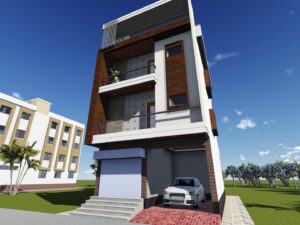Overview of the 770 Sqft. 35’x22′ House Plan
The 770 square feet house plan, with dimensions of 35 feet by 22 feet, epitomizes compact yet efficient living. This intelligently designed plan optimizes every inch of space, providing a cozy and functional environment suitable for modern living. The overall layout of the house is meticulously crafted to ensure that all essential areas are adequately accommodated without sacrificing comfort or style.
The house includes a thoughtful arrangement of rooms and spaces. Typically, it features two bedrooms, making it ideal for small families or couples. The living area is designed to be the heart of the home, offering a welcoming space for relaxation and socializing. Adjacent to the living area, the kitchen is compact yet fully equipped, providing all the necessary amenities for everyday cooking and dining. The house also includes one or two bathrooms, depending on the specific design variant, ensuring convenience and privacy for the residents.
What sets this house plan apart is its focus on maximizing space utilization. Clever design elements such as built-in storage solutions, multi-functional furniture, and open-plan living areas contribute to the overall efficiency and comfort. The layout is also designed to allow for ample natural light and ventilation, enhancing the livability of the space.
This 770 square feet house plan is particularly well-suited for various target audiences. Small families will appreciate the manageable size and ease of maintenance. Single professionals will find it an affordable and practical housing solution. Retirees looking for a cozy and low-maintenance home will also find it appealing. The compact size does not compromise on the quality of living, making it a versatile option for those seeking a balance between comfort and practicality.
Design Considerations and Space Optimization Techniques
The design of a 770 sqft., 35’x22′ house plan necessitates thoughtful considerations to maximize both space and comfort. The layout is meticulously crafted to make the most of every square foot, ensuring a functional and inviting living environment. Central to this approach is the use of open floor plans, which create a sense of spaciousness and fluidity by minimizing barriers between living, dining, and kitchen areas. This continuity not only enhances the visual expanse but also facilitates easier movement and interaction within the home.
In small homes, multifunctional furniture is indispensable. Items such as fold-out tables, sofa beds, and expandable dining sets serve dual purposes, thereby conserving space without sacrificing utility. Additionally, smart storage solutions play a critical role in keeping clutter at bay. Built-in shelving units, under-stair storage, and overhead cabinets are examples of how storage can be seamlessly integrated into the design, maximizing every available nook and cranny.
Architectural elements specifically designed to enhance space efficiency are also pivotal. Sliding doors, for instance, save precious floor area that would otherwise be required for door swings. Loft spaces provide additional storage or sleeping areas without encroaching on the primary living space. The strategic use of vertical elements, such as tall windows and higher ceilings, further amplifies the perception of space.
Natural light and ventilation are crucial factors in making a small space feel larger and more welcoming. Large windows, skylights, and strategically placed openings ensure that the interior is bathed in natural light, creating an airy and expansive atmosphere. Proper ventilation not only improves air quality but also maintains a comfortable indoor environment, reducing the reliance on artificial cooling and heating systems.
Sustainable and energy-efficient design features contribute significantly to the overall appeal and functionality of the house plan. Energy-efficient windows, proper insulation, and the use of eco-friendly materials not only reduce the environmental footprint but also offer long-term cost savings. Incorporating these elements into the design ensures that the home is not only space-efficient but also sustainable and cost-effective.





